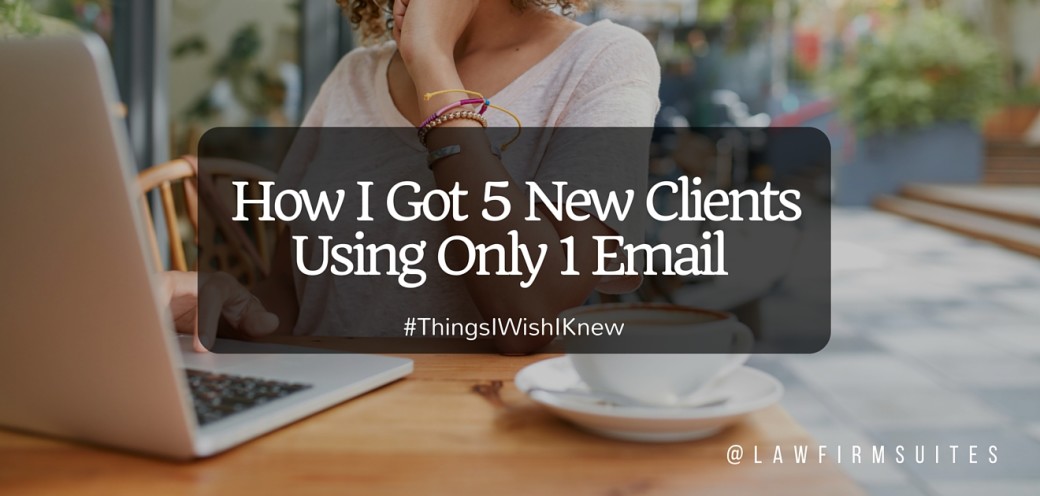In this week’s edition of Things I Wish I Knew, solo attorney Joleena Louis explains how her decision to use email to ask for referrals resulted in new business for her firm.
Since starting my practice, one piece of advice I’ve heard repeatedly was to ask for referrals. Logically, it seems like the obvious way to get referrals. But in practice, directly asking for referrals makes many lawyers uncomfortable.
Asking for referrals feels a lot like asking someone for a favor because you’re letting them know you need new business for your firm and a referral is what will help your practice succeed. Without referrals, your law practice is guaranteed to suffer financially.
For many, asking for favors is difficult because they don’t want to seem needy and they fear rejection. Personally, my biggest fears about asking for referrals were that it would come off as too salesy or too desperate.
Recently, I suddenly became motivated to get over those fears after reading several articles that recommended I try asking for referrals. In these articles, the point was made that many of my referral sources WANT to help me and it actually gives people a great sense of satisfaction to do favors for others. Also, many people will want to do you a favor in the hopes that you’ll reciprocate some day.
I realized that not asking for what you need or want in life will often result in not getting it because you won’t always be thought of by others. People won’t realize they can even do something for you until you reach out and ask.
So I decided to try it. As it turns out, I learned that there is a way to ask for referrals that doesn’t make me feel desperate at all and it’s easier than I thought.
Here’s what happened:
What I did
I used MailChimp to send an email to 105 people on March 14th. As a result, 54 people opened the email, and 40 replied with possible referrals. From those replies, I spoke with 15 referrals and retained 5 new clients. This does not include the consultations I have scheduled for April so it is possible I could close even more business because of this email.
Why this worked
When you do good work, people will send a friend to you when asked if they know an attorney. But if you ask for a referral, they will sometimes take the extra step of reaching out to people who may not have asked. That’s why it’s like asking for a favor, which was the subject of this email: “Can you do me a favor…?”
Reasons why I think this email was successful include:
- Leveraged my current relationships. I think this worked because I asked people who already had a relationship with me. They felt a desire to help me because they feel loyal to our relationship. It also gave them an easy way to pass on my contact information. Everyone I talked to about receiving the email thought it was a great idea and many said having the actual email to forward to possible referrals was very helpful.
- Focused on design. I also think the design of the email was essential to its success. Nowadays, people are more attracted to visuals than they are to words; therefore, combining compelling images with a straightforward call-to-action will increase the likelihood people will actually read your email.
- Reflected my personal brand. I tried to use images that aligned with my personal brand and were similar to those I would post on my social media profile, such as my Instagram or Facebook. In fact, I plan to recycle each of the panels I used in my email for social media posts.
- Fewer words. I got to what I was asking for right away and made a point to keep the copy of the email simple. This made it more inviting to read and pass along.
- Offered an incentive. I always offer a free consultation to referrals because I trust that the potential clients my referral sources send me are qualified leads. My contacts were more willing to share my email with their connections because I wasn’t hitting anyone up for money. If their friends or colleagues decided not to use my services, then they could easily walk away without losing anything.
How you can do it too
Step 1: Select an email list of referral sources or build one. In my case, I used members of my newsletter list. If you don’t have an email list already, then you’re missing out on some great marketing opportunities.
Step 2: Decide on an email marketing solution. I used MailChimp, but you can use your current CRM. What I like about MailChimp is that you can easily design your own email templates. If you have fewer than 2,000 subscribers you can use MailChimp to send up to 12,000 emails per month at no cost. You can also purchase a monthly plan with more features at a low cost.
Step 3: Design an email template. The template I used is the format I use for most of my email campaigns. I created all of my graphics using Canva, a drag-and-drop design website that’s easy to use. I also pull stock photos from Pixabay if I can’t find what I want on Canva.
Step 4: Send your email and monitor your results. It took me less than 20 minutes to create and launch my email.
What I would do next time
While I certainly wouldn’t send an email like this too often, I think I’ll do it at least twice a year so it can serve as a reminder. You never know when circumstances might change or when some of your referral sources will meet someone who can use your services.
Next time, I would include my contact information at the top of the email because only a few people actually clicked the link to schedule the consultation. Although, I will still keep my call-to-action button for the consultation, just in case.
In the future, I would also experiment with alternate subject lines. “Can you do me a favor…” worked once because I think my contacts were curious about how they could help me. However, I could also make it more personalized by including the contact’s name in the subject.
All in all, this experiment is has made me get over my fear of asking for referrals. When I sent that email I was still concerned it may come off as salesy or desperate; however, the feedback I received from colleagues has quieted those fears.
Asking for referrals is what successful solos do because they don’t allow fear to stop them from going after what they want. My recommendation would be to test it out, see what happens and ask for feedback.
Take a chance and ask for referrals. You never know how it will turn out.


